The magic of migration hotspots: Point Pelee
19 April 2023 · Bas van den Boogaard · 4209 × bekeken
Throughout the world there are truly fascinating places where terrestrial bird migration manifests itself in full force. Thanks to geography and under specific weather conditions, birds concentrate at these sites during migration. For birders (and researchers), the species diversity of these so-called migration hotspots and the sheer number of birds act as a real magnet. The day-to-day changes in species composition and the variation in bird numbers give a highly dynamic feel. Generally, you can recognize three types of migration hotspots: 1) active daytime migration of large birds like raptors, storks, ibises, pelicans etc., 2) active daytime migration of songbirds and 3) sites where nocturnal and daytime migrants make landfall and concentrate.
For European birders places like Falsterbo (Sweden), the Bosporus (Greece/Turkey), Gibraltar (Iberian Peninsula), southern Israel, the Scillies (UK) and Heligoland (Germany) have been long-time favourites. In recent decades, similar sites across the world became known, including the massive raptor migration at Veracruz (Mexico), the songbird and shorebird migrant traps at Beidaihe/Happy Island (China) and the massive daytime raptor and songbird migration at Batumi (Georgia). Another one of these sites is Point Pelee, in southern Canada. Point Pelee is well-known for its springtime migration of songbirds.
This short article describes some general aspects of bird migration at Point Pelee, and why it is such a lure to birders. Many of our highlights during a trip to Point Pelee in May 2022 are included as well. All three of us (Bas van den Boogaard, Han Zevenhuizen and Ruud van Beusekom) had visited North America before, so the focus was experiencing the entire migration phenomenon and adding some new species to our lists.
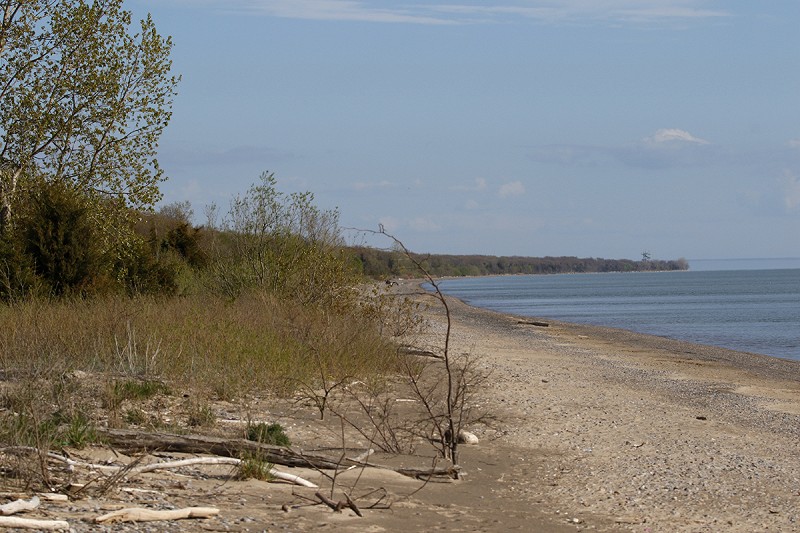 Point Pelee looking southwards, along the western shore. In the distance the tip of the peninsula and the watchtower, Point Pelee, 12 May 2022 (Bas van den Boogaard)
Point Pelee looking southwards, along the western shore. In the distance the tip of the peninsula and the watchtower, Point Pelee, 12 May 2022 (Bas van den Boogaard)
Migratory dynamics
Birding in tropical forests is one of my favourite activities, with the ongoing battle between birder and super skulking ground dwellers or fast-moving high canopy flocks. Trips like these require great planning, sampling numerous sites with altitudinal variation and different forest types. A very different vibe and feel from being stationary at a migratory hotspot for weeks! The birds come to you, instead of the other way round. I have had numerous birding trips of both types and must admit there’s something special about experiencing the dynamics of migration. Despite all the predictive information about bird densities and non-stop updates on bird sightings, “testing the air” on yet another new morning is magic. Did new birds arrive? Are there birds on active migration? Are the bushes loaded with warblers or did the last days’ birds leave all together? Could it be the day for new species, or anything rare? It’s the prospect, the expectations.
Point Pelee centres in the Atlantic flyway, one of the four major flyways in North America (the others being the Mississippi, Central and Pacific flyways). Point Pelee is a clear landmark along the northern shore of Lake Erie: it’s a peninsula pointing southwards for about 10 km. Any bird crossing the 50 km wide Lake Erie during its northbound migration will orientate itself towards that tip. Along the northern shore of Lake Erie (and other places along the Great Lakes’ shores), there are somewhat similar landscape features but none so attractive to migrating birds as Point Pelee.
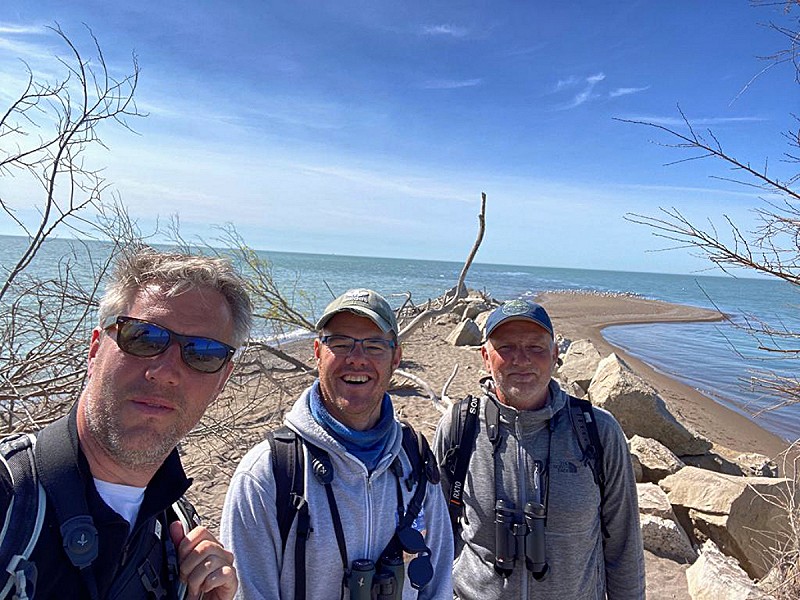 The Tip, looking southwards with Han Zevenhuizen (left), Bas van den Boogaard (centre) and Ruud van Beusekom (right), Point Pelee, 9 May 2022 (Han Zevenhuizen)
The Tip, looking southwards with Han Zevenhuizen (left), Bas van den Boogaard (centre) and Ruud van Beusekom (right), Point Pelee, 9 May 2022 (Han Zevenhuizen)
Migration starts fairly early in spring, with a wide range of ducks, geese and gull species. In April, shorebirds start to kick in, with raptors, swallows, blackbirds etc. From the third week of April, the North American colour bonanza of Setophaga warblers truly kicks in. Formerly known as Dendroica warblers, for most European birders this group of small insectivorous migrants has a special interest. Foremost, in spring and summer most species have a very colourful plumage. In our opinion, species like Blackburnian Warbler, Magnolia Warbler and Bay-breasted Warbler rank among the most splendid North American bird species. For us, and many readers of this website, seeing (let alone finding) a North American rarity in Europe is a true fall highlight. Obviously, fall plumages of these warbler species are much different from their breeding plumage, but if you have an interest in rarities, the Setophaga species are top-of-the-bill!
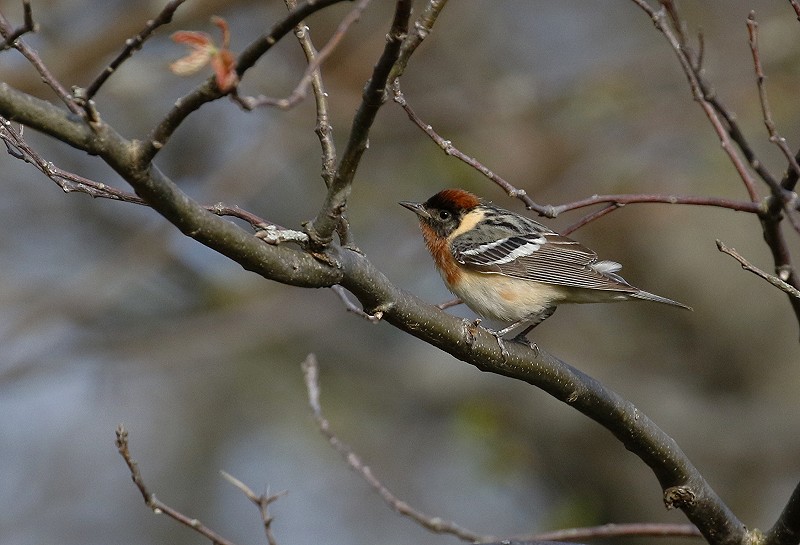 Bay-breasted Warbler Setophaga castanea, male, in crispy summer plumage. We had daily encounters with this species, a true gem and classic long-distance migrant breeding in coniferous (boreal) forests in Canada and wintering in north-western South America, 11 May 2022 (Bas van den Boogaard)
Bay-breasted Warbler Setophaga castanea, male, in crispy summer plumage. We had daily encounters with this species, a true gem and classic long-distance migrant breeding in coniferous (boreal) forests in Canada and wintering in north-western South America, 11 May 2022 (Bas van den Boogaard)
We planned our trip to match the highest species diversity and highest number of birds of the Setophaga warblers, in the first half of May. There’s still a chance for a late Pine Warbler, for instance, but also the opportunity for the first Connecticut Warbler of the season. This article gives a good overview of the timing and abundance of all the warblers in Ontario, with an emphasis on Point Pelee. Despite its tiny surface area, Point Pelee has recorded at least 42 warbler species over the years, with 36 species seen most years. Good fall-out conditions early May can yield 25-30 warbler species on a single day! During our stay, we recorded 29 species of wood warblers (Setophaga, Vermivora, etc.), 7 species of vireo (Vireo), 6 species of thrushes (e.g. Catharus), and 10 species of sparrows (e.g. Zonothricia and Melospiza), among many other species. Many southern species overshoot while on migration, i.e. they keep on flying well past their regular breeding grounds. For instance, during our trip we saw Mississippi Kite, a species recorded almost yearly at Point Pelee but in very low numbers.
The layout of Point Pelee
The tip of Point Pelee is truly a point, ending in a shallow sand spit. This sand spit used to be extensive, but due to recent storms much has been eroded. During our visit, the sand spit was only 100 m long. From the extreme tip northwards, almost immediately shrubs and low trees grow. Further on, the peninsula widens, and true forest appears with high trees (partially of the nowadays rare Carolinian forest type). This forest is clearly adapted to a land climate: at the start of our visit on 7 May, the trees had leaf buds, which were fully closed, but on our departure on 15 May most trees had fully emerged leaves. Obviously, the insects respond accordingly, as do the insectivorous birds. Point Pelee is a National Park and has numerous small trails through the woods. Our favourite was the trail running along the westside of the peninsula, bordering the edge of the forest. In the late afternoon, the setting sun warms the forest edge, attracting lots of migratory warblers (and other birds), giving excellent views and photographic opportunities. With so many birds giving excellent views at the end of the day, we dreaded the moment the sun would set. Each day, a race against time!
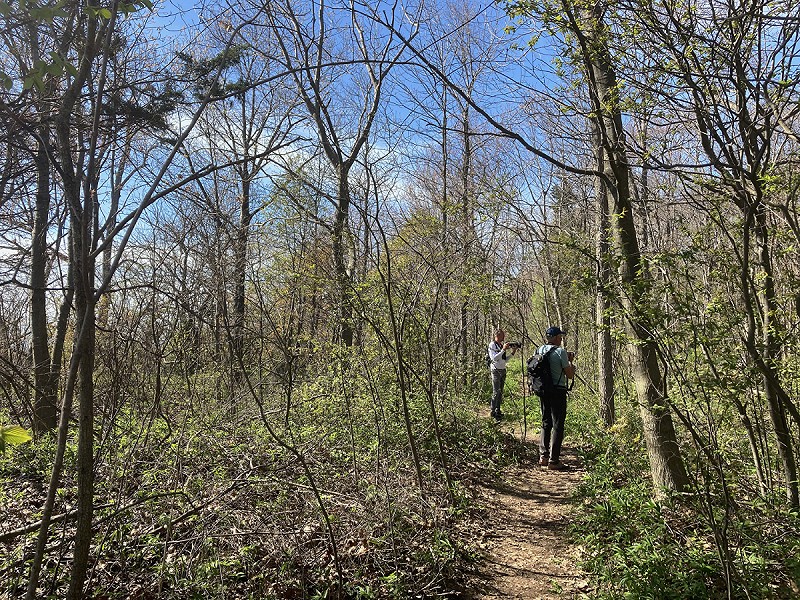 Ruud and Han working the trail along the westside of the peninsula. Throughout the park there are many such trails and birding these open woods with leaves just emerging is fairly easy, Point Pelee, 11 May 2022 (Bas van den Boogaard)
Ruud and Han working the trail along the westside of the peninsula. Throughout the park there are many such trails and birding these open woods with leaves just emerging is fairly easy, Point Pelee, 11 May 2022 (Bas van den Boogaard)
Part of Point Pelee consists of swamp forest, with several breeding pairs of Prothonotary Warbler. Beyond the forest of Point Pelee, there is a large swamp with several interesting breeding species. More interesting is Hillman Marsh, just outside the Point Pelee borders. This is a small conservation area that is really good for migratory shorebirds. If forest birding is slow, or you’re just up for something different, a stop at Hillman Marsh is a good alternative. During our trip we had a good selection of shorebirds, all in nice summer plumage. One last feature of Point Pelee that literally stands out, is a tall watchtower built in 2019.
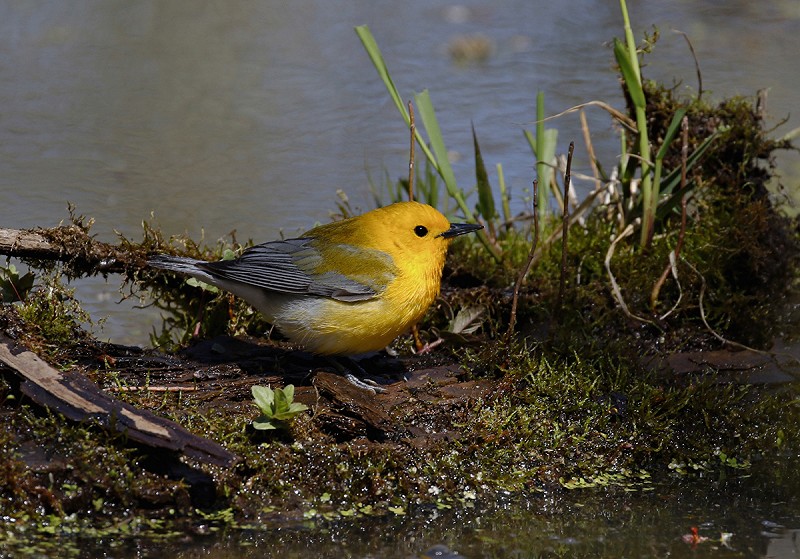 Prothonotary Warbler Protonotaria citrea, one of the residential breeding birds, 8 May 2022 (Bas van den Boogaard)
Prothonotary Warbler Protonotaria citrea, one of the residential breeding birds, 8 May 2022 (Bas van den Boogaard)
Many passerine species in Europe are diurnal migrants (or partial diurnal/nocturnal), but in North America they’re mainly nocturnal. Contrary to many observers in the Netherlands (and many other places in Europe), who watch and count songbirds on active migration during the day, this is not the case in North America. However, Point Pelee is one of the very few exceptions. Due to its geography, nocturnal migrants seem to get disoriented around Point Pelee and tend to keep flying in the early mornings. There’s even the odd phenomenon of “reverse migration”, when many birds fly southwards, and cross the water of Lake Erie. Anyway, it was only the three of us and one young and keen Canadian birder who picked up the idea of watching daytime songbird migration from the watchtower. We observed and photographed many songbirds passing by at eye level. Within hours we got somewhat experienced in identifying fly-by warblers, vireos, etc.! Another interesting feature are the somewhat solitary large trees, with flower buds that had just opened. Two of those trees, right next to the water at the extreme southern tip, attracted wave after wave of feeding warblers, vireos, tanagers and flycatchers during three mornings with strong migration.
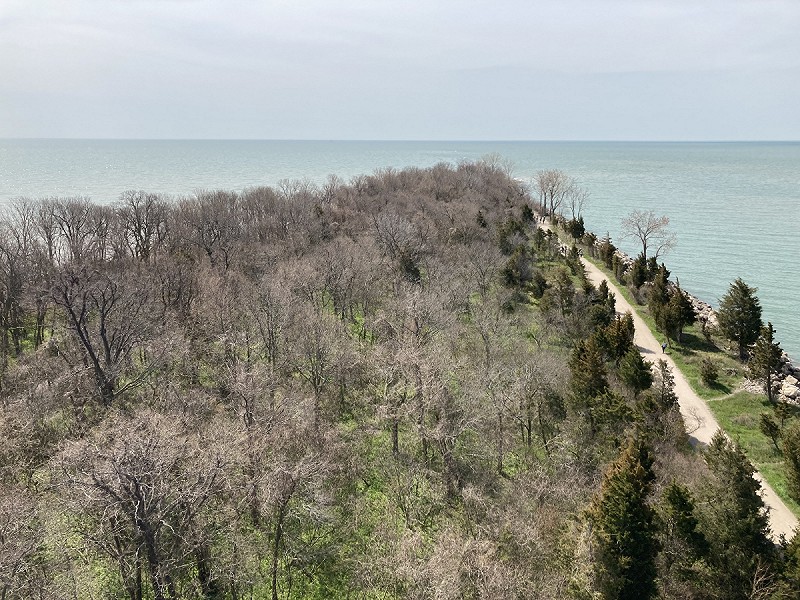 View from the watchtower, looking towards the tip (south). The understory of the forest becomes green, but most large trees are still without leaves. In this image, halfway along the water’s edge several large flowering trees are visible, attracting many songbirds. From this viewpoint many migrating songbirds were observed in a “reverse” direction, passing by at eye level, Point Pelee, 10 May 2022 (Bas van den Boogaard)
View from the watchtower, looking towards the tip (south). The understory of the forest becomes green, but most large trees are still without leaves. In this image, halfway along the water’s edge several large flowering trees are visible, attracting many songbirds. From this viewpoint many migrating songbirds were observed in a “reverse” direction, passing by at eye level, Point Pelee, 10 May 2022 (Bas van den Boogaard)
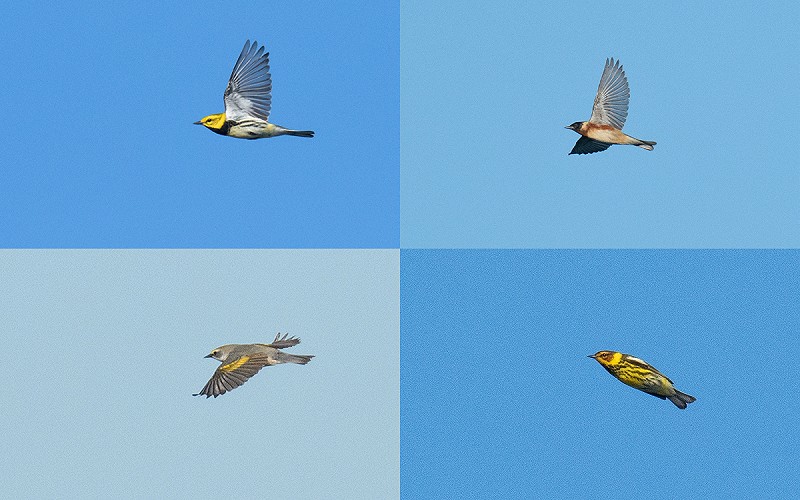 Warbler fly-bys from the watchtower: top left Black-throated Green Warbler Setophaga virens, top right Bay-breasted Warbler Setophaga castanea, lower left Golden-winged Warbler Vermivora chrysoptera and lower right Cape May Warber Setophaga tirgrina, Point Pelee, 10 - 11 May 2022 (Han Zevenhuizen)
Warbler fly-bys from the watchtower: top left Black-throated Green Warbler Setophaga virens, top right Bay-breasted Warbler Setophaga castanea, lower left Golden-winged Warbler Vermivora chrysoptera and lower right Cape May Warber Setophaga tirgrina, Point Pelee, 10 - 11 May 2022 (Han Zevenhuizen)
Day-to-day highlights
Starting in the afternoon of 7 May at the Niagara Falls we got our first taste of North American birds. A bit of a touristy place, for sure, but we can highly recommend visiting the falls. A magnificent site indeed! We saw common bird species like Myrtle Warbler, Yellow Warbler, Cliff Swallow, Northern Rough-winged Swallow, Chimney Swift and Warbling Vireo. Thousands of breeding Ring-billed Gulls and hundreds of Double-crested Cormorants on a cliff right next to the falls were also impressive.
 Niagara Falls, not a bad place to start a birding trip, Ontario, 7 May 2022 (Bas van den Boogaard)
Niagara Falls, not a bad place to start a birding trip, Ontario, 7 May 2022 (Bas van den Boogaard)
On the morning of 8 May, we birded Hillman Marsh. This conservation area has shallow water with muddy fringes, which can be excellent for shorebirds. The entire area was filled with birds: there’s constant activity of several swallow species, warblers and sparrows in the bushes nearby, ducks, Sora calling, Sandhill Cranes and Bald Eagles flying around, and every single reed stem seems to have its own Red-winged Blackbird. The afternoon was spent at Point Pelee, getting a feel for the area. In quick succession we saw species like Palm Warbler, American Redstart, Black-and-white Warbler, Black-throated Blue Warbler, Prairie Warbler, Northern Parula, Blue-headed Vireo, Hermit Thrush, Veery, White-crowned Sparrow and Clay-colored Sparrow. The first of “many-to-come” Yellow Warblers, Least Flycatchers, Common Yellowthroat, Baltimore Oriole, Rose-breasted Grosbeak and Blue Jays showed up.
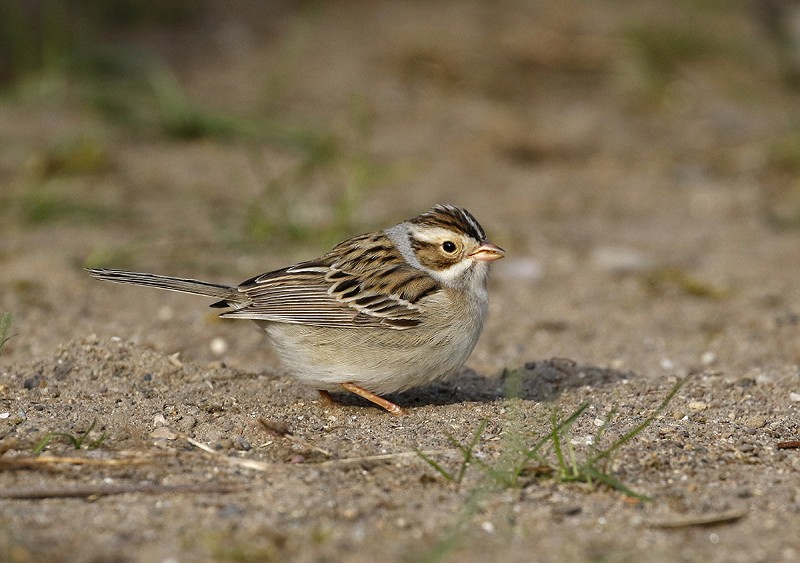 Clay-colored Sparrow Spizella pallida, Point Pelee, 8 May 2022 (Bas van den Boogaard)
Clay-colored Sparrow Spizella pallida, Point Pelee, 8 May 2022 (Bas van den Boogaard)
Point Pelee in spring, especially in May, means many birds but also many birders! After a two-year closure due to the Covid pandemic, many birders were very eager to have their share of spring migration at Point Pelee. Initially, I was somewhat afraid it would affect our birding experience, but it turned out to be the opposite: the people are very laid-back and soon you start recognizing people, exchange information and become part of a temporary birding community. Many novice birders were guided as part of a bird festival event, but mixed in were plenty of keen and experienced birders. Listers and year-listers, ID-nuts, DIY-ers, photo-geeks, you name it, they were all there! It’s always fun to get acquainted with that young fanatic birder using his car as a camping facility, the year-lister on bike (speaking of low-carbon birding!) or the local “I’m in every bird-information network you can imagine”. With so many birders, rarities are bound to show up. We refrained from chasing these rarities, focusing on finding our own birds. The exception being reports of Kirtland’s Warbler, Cerulean Warbler and Golden-winged Warbler. Kirtland’s Warblers were reported three times during our stay, all ending up being female Magnolia Warblers. The third time we even left our beers at Freddy’s… all in vain. So far for the Kirtland’s! Fortunately, the Ceruleans were a bit easier, and besides visiting two individuals found by others, we managed to find one bird by ourselves. Some more individuals were found as well, so it turned out to be a good spring for Cerulean Warbler. There is more to the story on rare birds, and how to find and ID them.
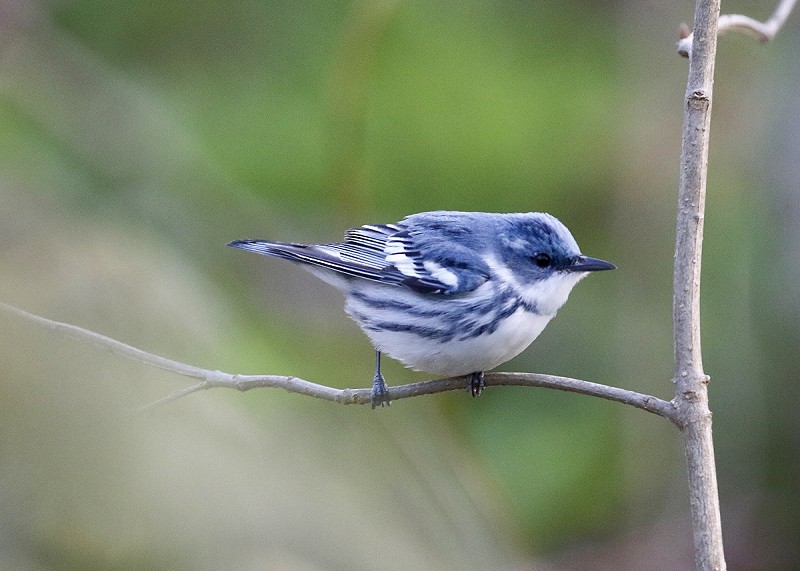 Cerulean Warbler Setophaga cerulea, this bird gave a real show foraging low in the bushes. Usually, Cerulean Warblers feed high in the canopy, but low spring temperatures push them lower down to feed in sheltered areas, Point Pelee, 10 May 2022 (Bas van den Boogaard)
Cerulean Warbler Setophaga cerulea, this bird gave a real show foraging low in the bushes. Usually, Cerulean Warblers feed high in the canopy, but low spring temperatures push them lower down to feed in sheltered areas, Point Pelee, 10 May 2022 (Bas van den Boogaard)
From the talks with fellow birders on our first day, we learned there was strong migration going on, and the mornings at the tip were really good. So, on 9 May we birded our way to the tip from the main parking area. Once at the tip, it was migration showtime. Apparently, the weeks before were cold, holding back the insectivorous migrants. As the weather changed, with air currents from the interior south of the U.S. resulting in clear skies and reasonable temperatures, a continuous arrival of new warblers, vireos, swallows, tanagers, kingbirds, flycatchers, thrushes and buntings was our bounty! At first it was a bit of a madhouse for us. Black-throated Green, Blackburnian, Magnolia, Yellow, Nashville and Chestnut-sided Warblers were everywhere, with birds perched out in the open on the breakwater rocks, not even 2 m away from us. At the same time the bushes around us (and the skies) had a constant flow of birds passing through, so it was hard to focus. Besides the warblers, there were regular flocks of Cedar Waxwings, Bobolinks, Red-winged Blackbirds, Baltimore Orioles, Blue Jays and Scarlet Tanagers passing by, together with single Indigo Buntings, Eastern Kingbirds, Rough-winged Swallows, Purple Martins, Chimney Swifts, etc. Later in the morning and in the afternoon, we walked the trails south and north of the main carpark. This gave us our first views of Yellow-throated, Blue-headed, Warbling and White-eyed Vireos (this last one a bit of a southern overshoot), together with species like Ovenbird, Veery, Wood Thrush, Northern Waterthrush, Hooded Warbler and our first sighting of a very obliging American Woodcock.
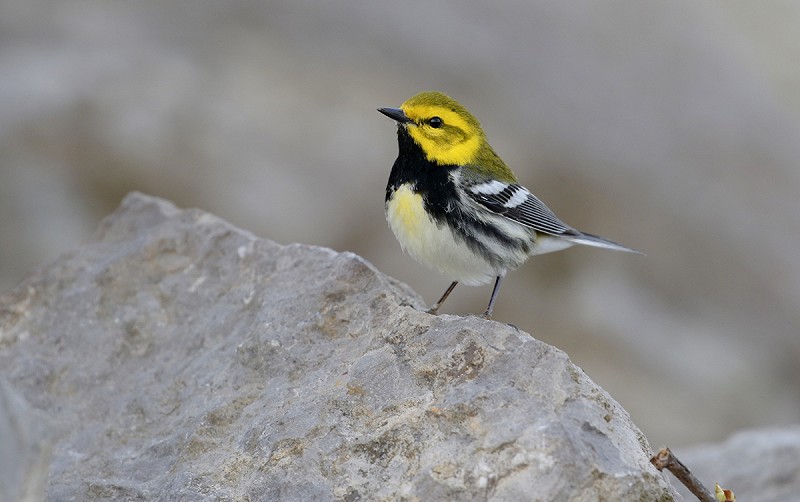 Black-throated Green Warbler Setophaga virens, giving a show on the breakwater rocks, Point Pelee, 9 May 2022 (Bas van den Boogaard)
Black-throated Green Warbler Setophaga virens, giving a show on the breakwater rocks, Point Pelee, 9 May 2022 (Bas van den Boogaard)
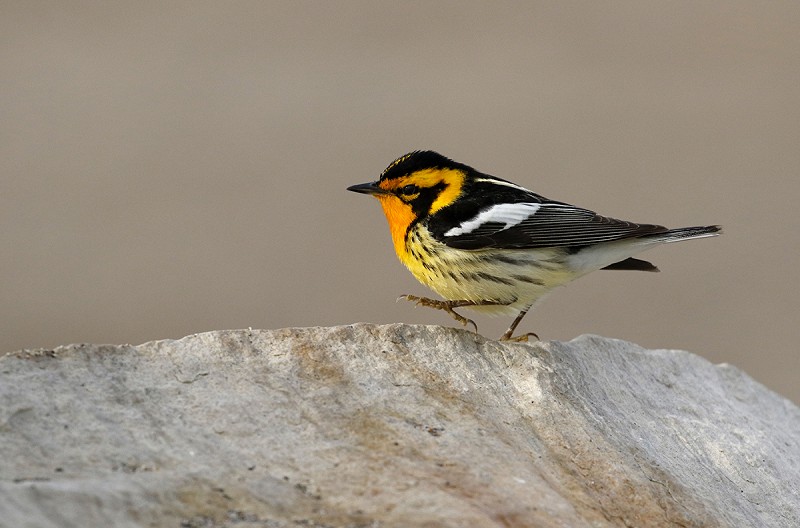 Blackburnian Warbler Setophaga fusca, this bird was flitting between the birders while chasing insects, Point Pelee, 9 May 2022 (Bas van den Boogaard)
Blackburnian Warbler Setophaga fusca, this bird was flitting between the birders while chasing insects, Point Pelee, 9 May 2022 (Bas van den Boogaard)
 Birders observing warblers among the breakwater rocks at the southern tip of Point Pelee, 9 May 2022 (Ruud van Beusekom)
Birders observing warblers among the breakwater rocks at the southern tip of Point Pelee, 9 May 2022 (Ruud van Beusekom)
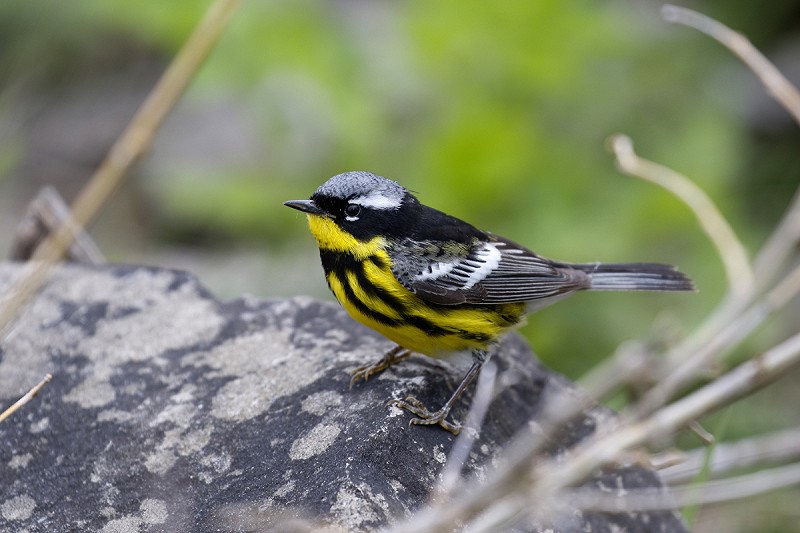 Magnolia Warbler Setophaga magnolia, Point Pelee, 9 May 2022 (Bas van den Boogaard)
Magnolia Warbler Setophaga magnolia, Point Pelee, 9 May 2022 (Bas van den Boogaard)
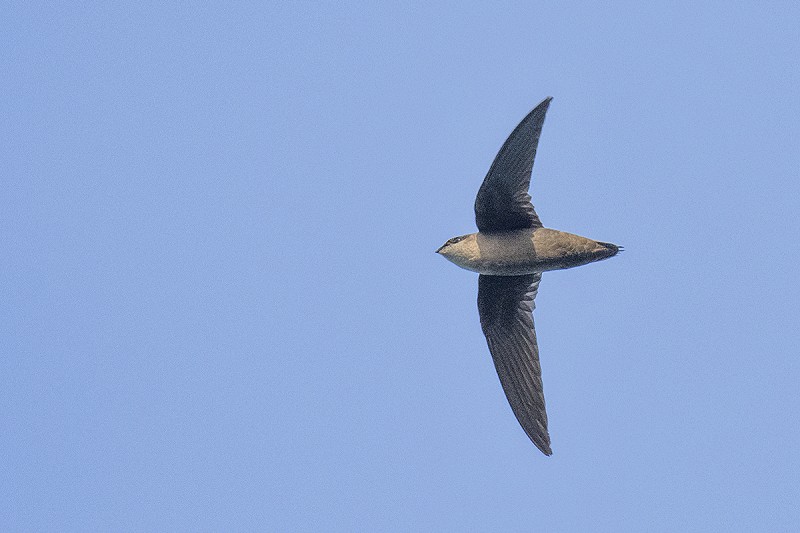 Chimney Swift Chaetura pelagica, frequently passing by together with Rough-winged Swallows, Purple Martins and Cliff Swallows. Note the “needles” at the end of the tail, characteristic of some swift species like the Asian needletails (Hirundapus), Point Pelee, 10 May 2022 (Han Zevenhuizen)
Chimney Swift Chaetura pelagica, frequently passing by together with Rough-winged Swallows, Purple Martins and Cliff Swallows. Note the “needles” at the end of the tail, characteristic of some swift species like the Asian needletails (Hirundapus), Point Pelee, 10 May 2022 (Han Zevenhuizen)
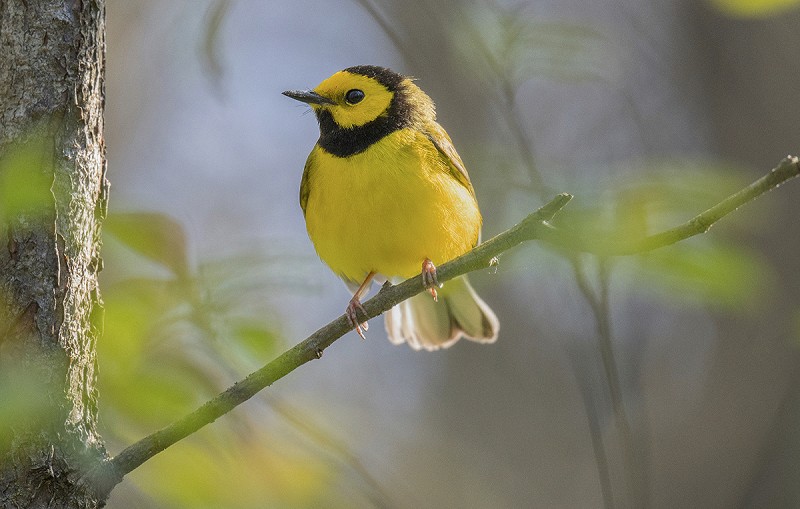 Hooded Warbler Setophaga citrina, Point Pelee, 10 May 2022 (Han Zevenhuizen)
Hooded Warbler Setophaga citrina, Point Pelee, 10 May 2022 (Han Zevenhuizen)
As the weather remained favourable for active migration, with “reverse migration” events in the morning, we stuck to a routine of early morning birding around the tip, and from there work our way northwards to other parts of the park. From 10 May until at least 12 May this proved to be a productive approach. Flycatchers were coming in, with Least Flycatcher being the most numerous and fairly easy to identify by sight. Most of the Empidonax flycatchers were silent, making identification of the other species not as straightforward. However, during our days at Point Pelee we also managed to see Alder, Willow, Acadian and Yellow-breasted Flycatchers, plus Eastern Phoebe, Olive-sided Flycatcher (only one), Eastern Wood Pewee, Eastern Kingbird and Great Crested Flycatcher.
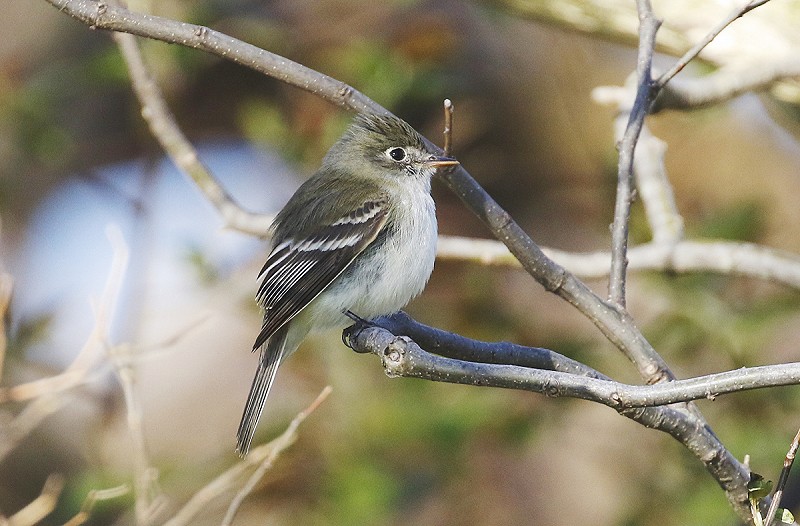 Least Flycatcher Empidonax minimus, the most numerous “empid” at Point Pelee. A short primary projection, short tail, cold grey below without any yellow or green tones, almost pure white tips to the median coverts and small fine bill is a good character combination for Least Flycatcher, Point Pelee, 10 May 2022 (Bas van den Boogaard)
Least Flycatcher Empidonax minimus, the most numerous “empid” at Point Pelee. A short primary projection, short tail, cold grey below without any yellow or green tones, almost pure white tips to the median coverts and small fine bill is a good character combination for Least Flycatcher, Point Pelee, 10 May 2022 (Bas van den Boogaard)
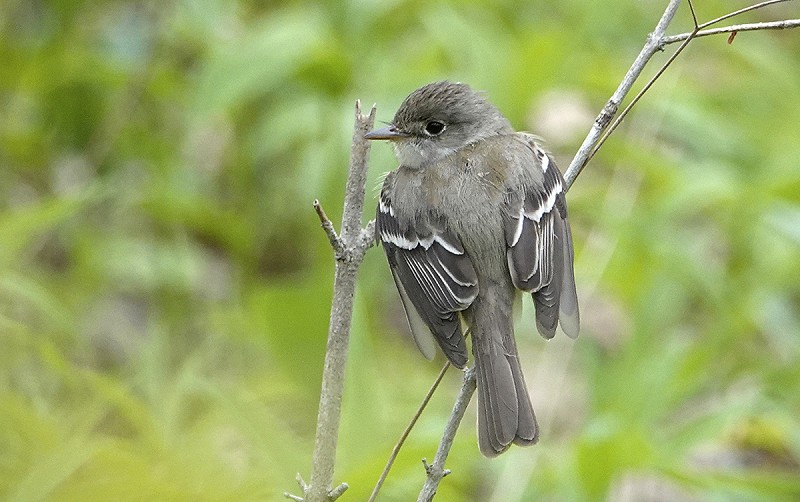 Alder Flycatcher Empidonax alnorum, together with Willow and Acadian flycatchers, make a true identification challenge! Many of the “empids” where calling/singing, making identification much more straightforward, Point Pelee, 11 May 2022 (Ruud van Beusekom)
Alder Flycatcher Empidonax alnorum, together with Willow and Acadian flycatchers, make a true identification challenge! Many of the “empids” where calling/singing, making identification much more straightforward, Point Pelee, 11 May 2022 (Ruud van Beusekom)
The Catharus thrushes are another interesting group of birds, with multiple species being long-distance migrants. Some Swainson’s Thrushes winter all the way down to northern Argentina. We saw multiple Swainson’s Thrushes daily, with Veery being about just as common. In total, we only recorded four Hermit Thrushes and two Grey-cheeked Thrushes. Wood Thrush (not a Catharus thrush) was common as well with daily records. All thrush species gave excellent views, with Grey-cheeked being the shyest.
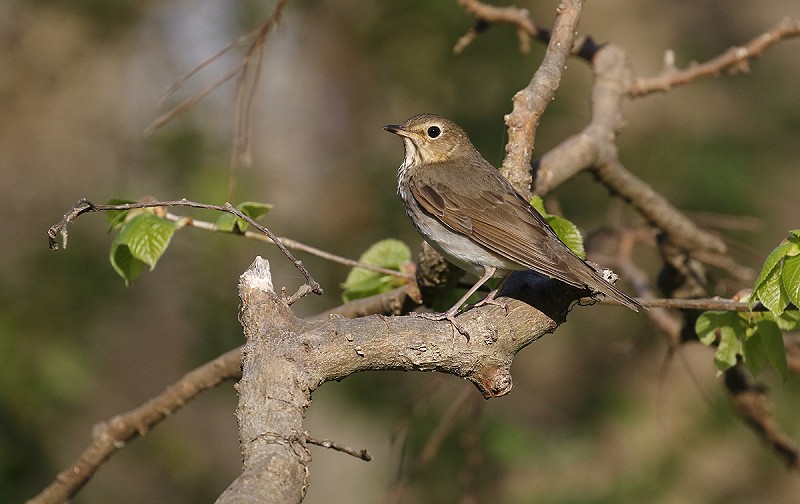 Swainson’s Thrush Catharus ustulatus, regularly showing on open branches or sitting on the trails. The bold and cream-colored eye-ring, sandy tones to the cheeks and evenly coloured back, rump and uppertail coverts are good characters for a quick identification, Point Pelee, 11 May 2022 (Bas van den Boogaard)
Swainson’s Thrush Catharus ustulatus, regularly showing on open branches or sitting on the trails. The bold and cream-colored eye-ring, sandy tones to the cheeks and evenly coloured back, rump and uppertail coverts are good characters for a quick identification, Point Pelee, 11 May 2022 (Bas van den Boogaard)
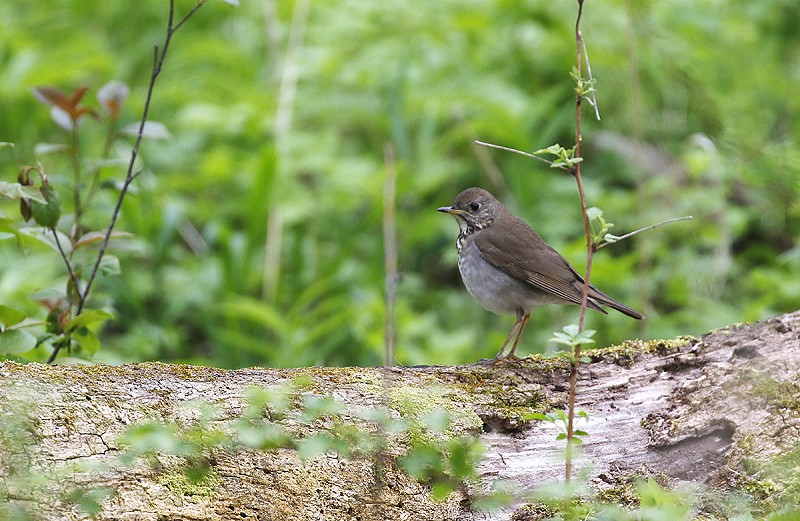 Grey-cheeked Thrush Catharus minimus, with typical grey flanks and cheeks and very bold but restricted black spots on the breast, Point Pelee, 11 May 2022 (Bas van den Boogaard)
Grey-cheeked Thrush Catharus minimus, with typical grey flanks and cheeks and very bold but restricted black spots on the breast, Point Pelee, 11 May 2022 (Bas van den Boogaard)
Another favourite part of the park are the wet forests north of the main carpark. Within the forest, there are patches of standing water, bordered by shrubs and trees. It also has parts with moist forest soils and dense low vegetation. This is prime habitat for both Northern and Louisiana Waterthrush, Hooded Warbler, Veery, Wood Thrush, Ovenbird, American Woodcock, Black-throated Blue Warbler and Mourning Warbler. An American Woodcock was very happy with a tiny patch of 4 m2. The bird was present for at least three days, and each day we paid him/her a visit. At its spot, close to a junction of two trails, a rusted iron bar was sticking out of the forest floor. The American Woodcock was always sitting close to this little marker. But every time you got there, knowing where the bird would be (more or less), it took several minutes before you’d find it. Its camouflage was truly superb, blending perfectly with the dry leaflitter.
Most Setophaga warblers feed at different levels in trees and higher shrubs, some with a clear preference for the higher canopy (like Cerulean Warbler). The Oporornis and Geothlypis warblers, however, prefer to forage on the forest floor and in the lower shrubs. They are skulky and often run on the ground like mice. During our stay at Point Pelee we had excellent views of at least four Mourning Warblers, with some brief sightings of other individuals as well. We hoped to catch the first Connecticut Warbler of the season, but this is a late migrant starting in the third week of May. That’s one for another trip!
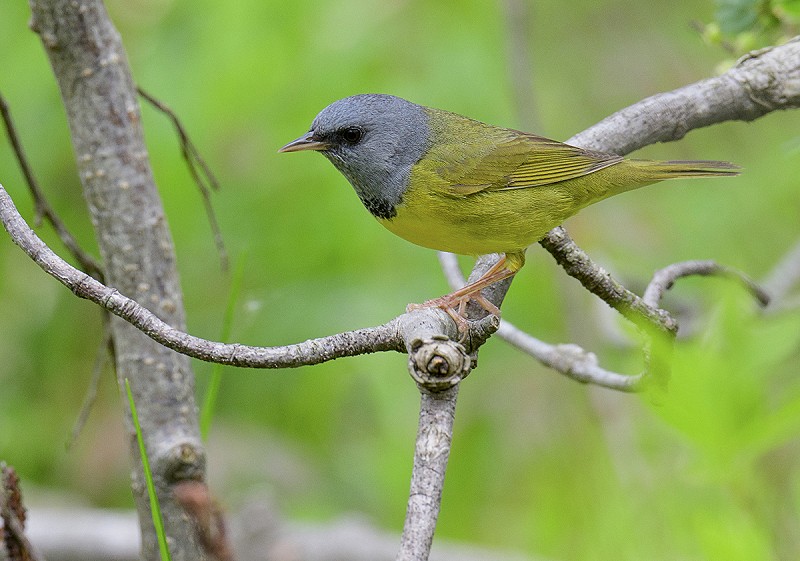 Mourning Warbler Geothlypis philadelphia, a species confined to the forest floor and low shrubs. Generally, a skulky species, but with some patience you can get good views, Point Pelee, 12 May 2022 (Han Zevenhuizen)
Mourning Warbler Geothlypis philadelphia, a species confined to the forest floor and low shrubs. Generally, a skulky species, but with some patience you can get good views, Point Pelee, 12 May 2022 (Han Zevenhuizen)
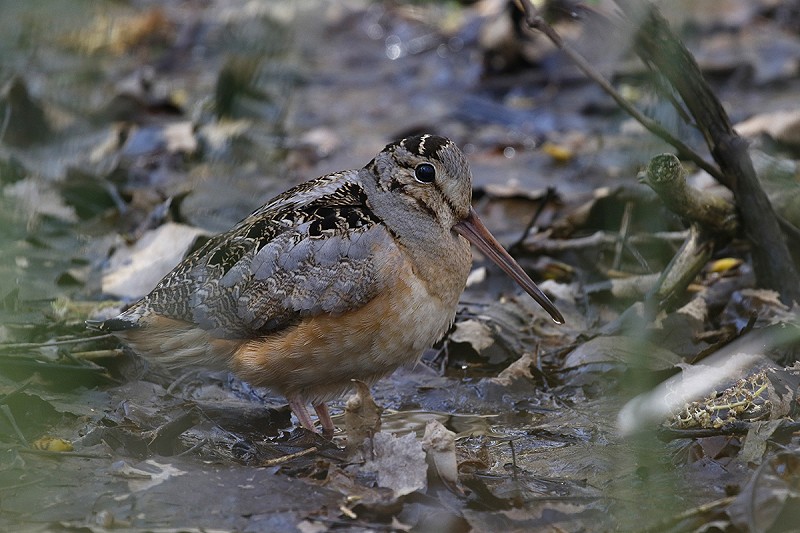 American Woodcock Scolopax minor, the grey scapulars and neck sides, orange underparts and its smaller size differ from its Eurasian counterpart (Eurasian Woodcock Scolopax rusticola), Point Pelee, 11 May 2022 (Bas van den Boogaard)
American Woodcock Scolopax minor, the grey scapulars and neck sides, orange underparts and its smaller size differ from its Eurasian counterpart (Eurasian Woodcock Scolopax rusticola), Point Pelee, 11 May 2022 (Bas van den Boogaard)
From 13 May till 15 May, we kept adding more wood warbler species, Empidonax flycatchers, cuckoos, etc. During a trip like this you get into a daily routine of regular checks of favourite spots. We would get a feel for the action at the tip, and depending on what was going on there, we would linger or move on into the park and look for settled birds. Each day we discovered new places in the park, like a small patch of open sand on the forest edge filled with sparrows. One afternoon, we took our time to slowly approach the birds, without any other birders in sight. Just within 10 m, we could observe and photograph the feeding Field, Clay-colored, White-crowned, White-throated and Savannah Sparrows. A Veery was hopping about as well.
Of the wood warblers, we added species like Wilson's, Orange-crowned, Blackpoll and Canada Warbler. Many more of the other species kept on putting on a great show too, with birds that had settled giving plenty of opportunities for study and photography. Cape May Warblers and Tennessee Warblers fed together in low berry bushes and Chestnut-sided Warbler was still one of the default species. Golden-winged Warbler was one of our “must see” species (and one of the few new for my life list), so despite being reluctant with twitching birds, we did visit a male bird south of the visitor centre. Some days later, we also saw a female in deep shrubs. During our trip, we also saw at least six Blue-winged Warblers.
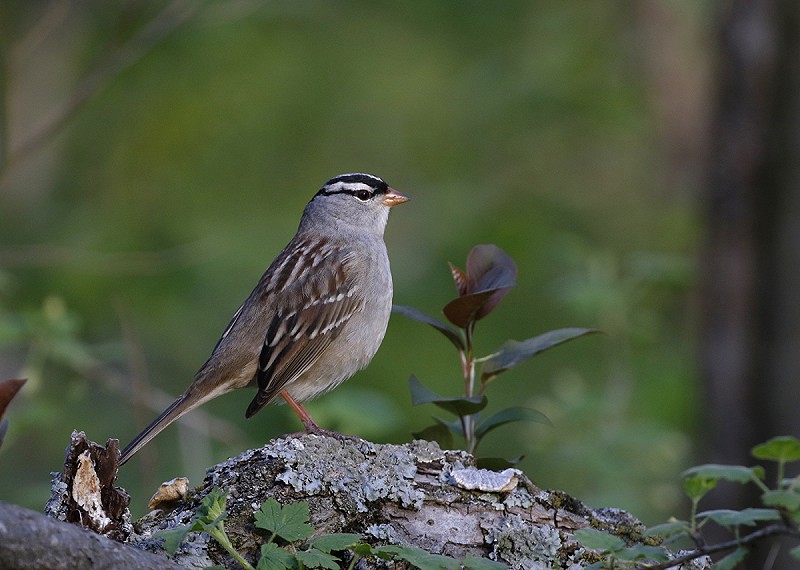 White-crowned Sparrow Zonotrichia leucopfrys, Point Pelee, 12 May 2022 (Bas van den Boogaard)
White-crowned Sparrow Zonotrichia leucopfrys, Point Pelee, 12 May 2022 (Bas van den Boogaard)
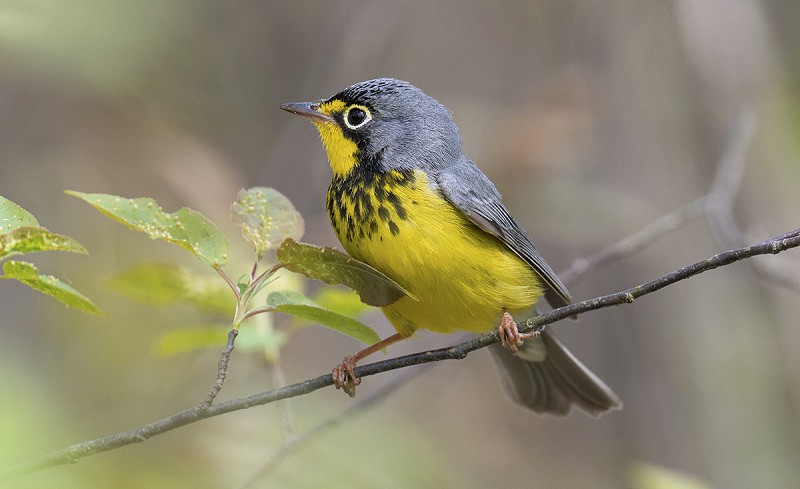 Canada Warbler Cardellina canadensis, Point Pelee, 13 May 2002 (Han Zevenhuizen)
Canada Warbler Cardellina canadensis, Point Pelee, 13 May 2002 (Han Zevenhuizen)
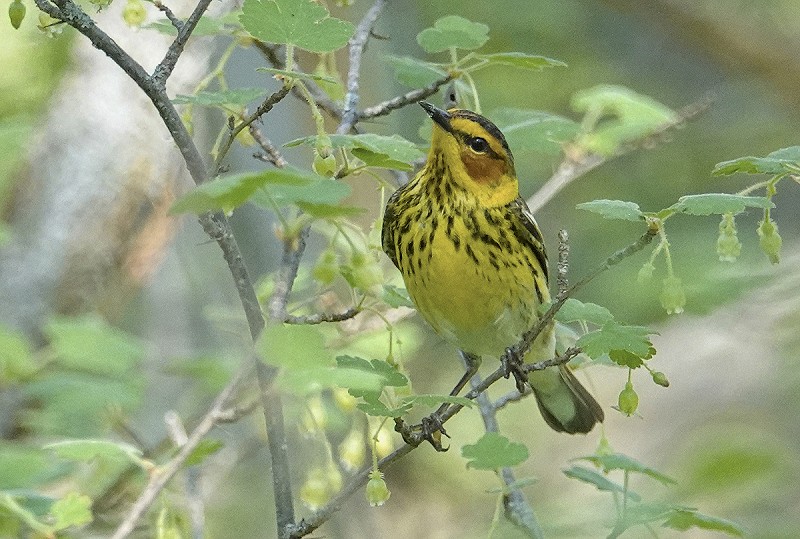 Cape May Warbler Setophaga tigrina, Point Pelee, 13 May 2022 (Ruud van Beusekom)
Cape May Warbler Setophaga tigrina, Point Pelee, 13 May 2022 (Ruud van Beusekom)
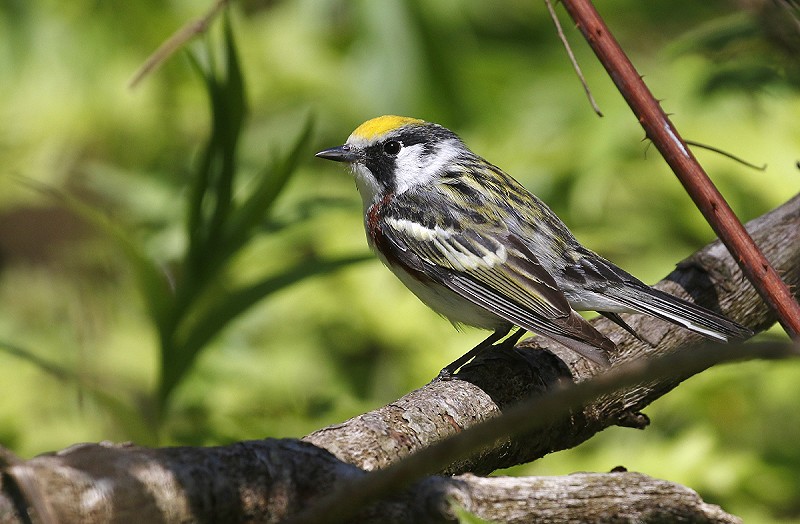 Chestnut-sided Warbler Setophaga pensylvanica, male, Point Pelee, 13 May 2022 (Bas van den Boogaard)
Chestnut-sided Warbler Setophaga pensylvanica, male, Point Pelee, 13 May 2022 (Bas van den Boogaard)
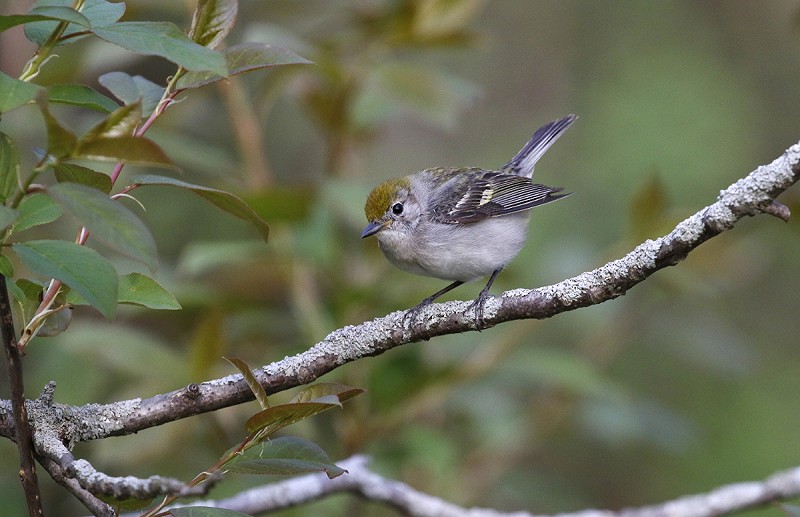 Chestnut-sided Warbler Setophaga pensylvanica, female, Point Pelee, 14 May 2022 (Bas van den Boogaard)
Chestnut-sided Warbler Setophaga pensylvanica, female, Point Pelee, 14 May 2022 (Bas van den Boogaard)
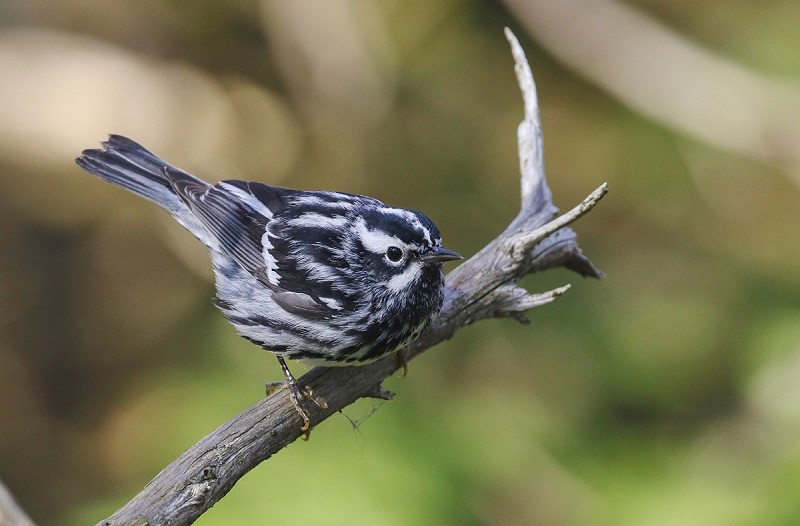 Black-and-white Warbler Mniotilta varia, seen daily within the park, 11 May 2022, Point Pelee (Bas van den Boogaard)
Black-and-white Warbler Mniotilta varia, seen daily within the park, 11 May 2022, Point Pelee (Bas van den Boogaard)
The western side of Point Pelee has many small, open grassy patches. In one of these patches, we found a small and very skulky sparrow. Its behaviour was typical for an Ammodramus sparrow: when flushed, it would fly away low above the grasses over a short distance and once landed, it would walk away in a mouse-like fashion. We had multiple occasions in which we knew precisely where the bird landed, but we always flushed it again further away from the initial landing spot. A nice little hide-and-seek game, quite different from all the very cooperative and colourful warblers! This little game also meant we could not immediately identify the bird. It was obviously an Ammodramus sparrow (generally very plain, thick short bill, short spiky tail feathers and typical behaviour), but which species? Grasshopper Sparrow is the most likely species, but Henslow’s is also possible. In the field, we had difficult light, and the bird certainly did not help playing hide-and-seek. Eventually we managed to get decent images and with some help from resident Dutch birder Jelmer Poelstra (guiding a tour in the area for BirdingBreaks.nl), it turned out to be a Grasshopper Sparrow.
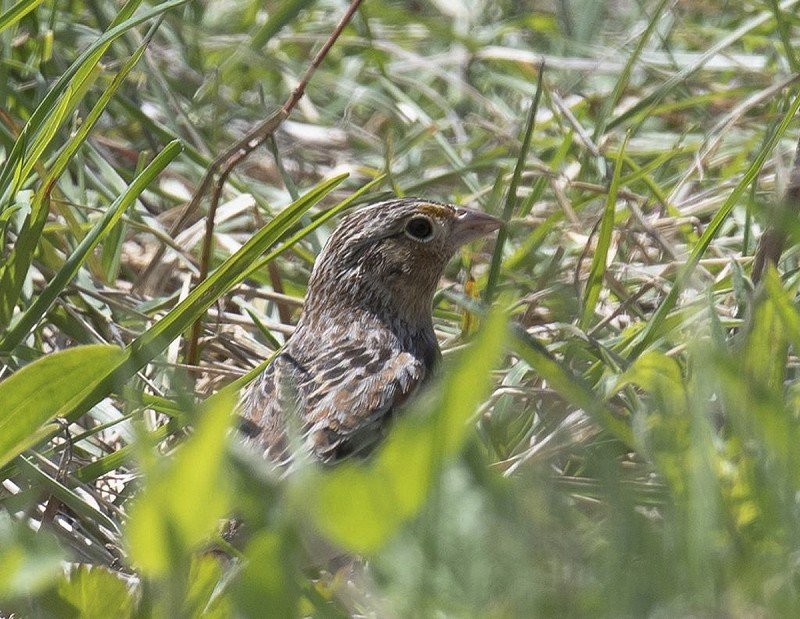 Grasshopper Sparrow Ammodramus savannarum, the very contrasting feathers on its back made us also consider Henslow’s Sparrow Centronyx henslowii, but the coloration of the head with yellow fore supercilium and buffy cheeks and throat make this a Grasshopper Sparrow, Point Pelee, 10 May 2022 (Han Zevenhuizen)
Grasshopper Sparrow Ammodramus savannarum, the very contrasting feathers on its back made us also consider Henslow’s Sparrow Centronyx henslowii, but the coloration of the head with yellow fore supercilium and buffy cheeks and throat make this a Grasshopper Sparrow, Point Pelee, 10 May 2022 (Han Zevenhuizen)
Another identification challenge turned out to be a vireo. On 12 May we birded our favourite western trail around midday. It was pretty hot with harsh light. Not ideal for photography, and after a morning with lots of action, bird activity had clearly slowed. A typical pattern in many places, which means it's that time of day when birding feels a bit like “work”. Keeping your focus can become a challenge! Anyway, Han saw a songbird feeding in low juniper bushes, which was very grey and drab. After a couple of minutes of observing, I mentioned it could be a vireo due to its heavy bill and long tail. But we had our default vireos as reference (Red-eyed, White-eyed, Yellow-throated, Blue-headed, Warbling and Philadelphia Vireo) and this bird certainly did not match with any of these. Instead of considering the entire vireo family of North America (i.e. rare species from the interior or the western United States), we took the wrong turn and started puzzling on a large wood warbler. All in vain, so after we took a whole series of images, we figured we could identify it later using other resources. Some 15 minutes after departure, we ran into Steve Pike. Steve is the type of birder that falls into the category “I’m in every bird-information network you can imagine”, but he’s also an experienced Point Pelee birder. He got very enthusiastic about our images of the bird, and we quickly returned to relocate it. It was still there, fortunately, because it turned out to be a Bell’s Vireo! The Province of Ontario has about 20 records, the majority at Point Pelee. It’s a species that occasionally overshoots from its breeding grounds in the interior or the western parts of the U.S. So, there you have it, we found the best (and dullest) bird of the week! Once we sent out the alerts, a rush of many birders followed. For many Canadian birders it turned out to be a new Provincial species or new to their Canadian list.
.jpg) Bell’s Vireo Vireo bellii, especially in harsh light a plain grey and featureless bird. In this image you can just see its two whitish wingbars, a faint yellow-green wash on the flanks, a broad but indistinct supercilium, bill with little hook at the tip, long tail, and strong grey-blue legs, Point Pelee, 12 May 2022 (Han Zevenhuizen)
Bell’s Vireo Vireo bellii, especially in harsh light a plain grey and featureless bird. In this image you can just see its two whitish wingbars, a faint yellow-green wash on the flanks, a broad but indistinct supercilium, bill with little hook at the tip, long tail, and strong grey-blue legs, Point Pelee, 12 May 2022 (Han Zevenhuizen)
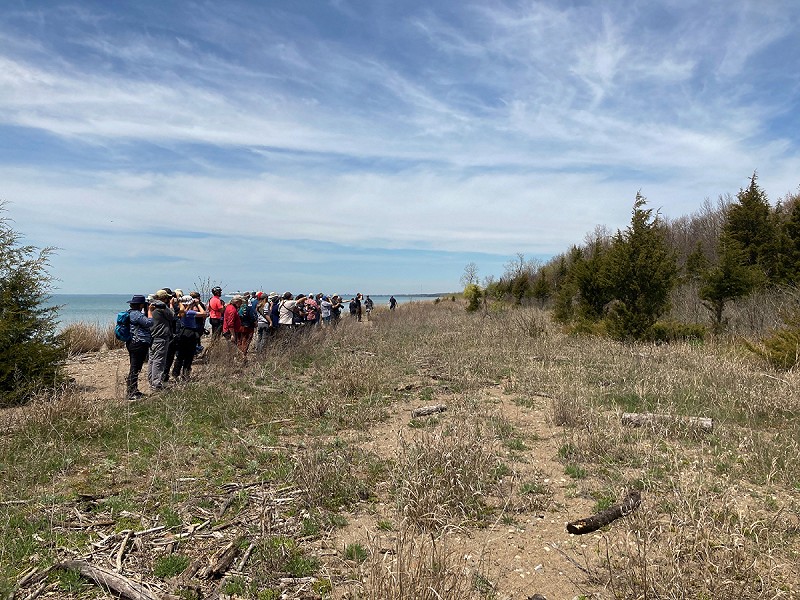 The first of many birders twitching the Bell’s Vireo. The bird favoured the low shrub inbetween the juniper trees, Point Pelee, 12 May 2022 (Bas van den Boogaard)
The first of many birders twitching the Bell’s Vireo. The bird favoured the low shrub inbetween the juniper trees, Point Pelee, 12 May 2022 (Bas van den Boogaard)
There are a couple of additional species that I would like to mention in this report, before closing off. From the 11 May onwards, we had a total of three Yellow-billed Cuckoos and two Black-billed Cuckoos. I guess we expected to see a bit more of these, but despite low numbers we had excellent views! On the 11 May, we had our first Black-billed and Yellow-billed Cuckoo within half an hour of each other; birds that most likely had just arrived. We found both at the forest edge, sometimes flying short distances but mostly sitting still for long periods. Approaching slowly, the birds could be photographed quite well.
We had been waiting for shorebirds to come in, and finally near the end of our trip they did. This gave a nice change from all the songbird spectacle in the forest. In the afternoon of 14 May, Hillman Marsh was filled with Calidris sandpipers and other shorebirds. We recorded around 50 Least Sandpipers, a Sanderling, two Stilt Sandpipers, two White-rumped Sandpipers, five Semipalmated Sandpipers, at least 30 Short-billed Dowitchers, Lesser Yellowlegs, a vagrant Willet, about 25 Semipalmated Plovers and two Grey Plovers.
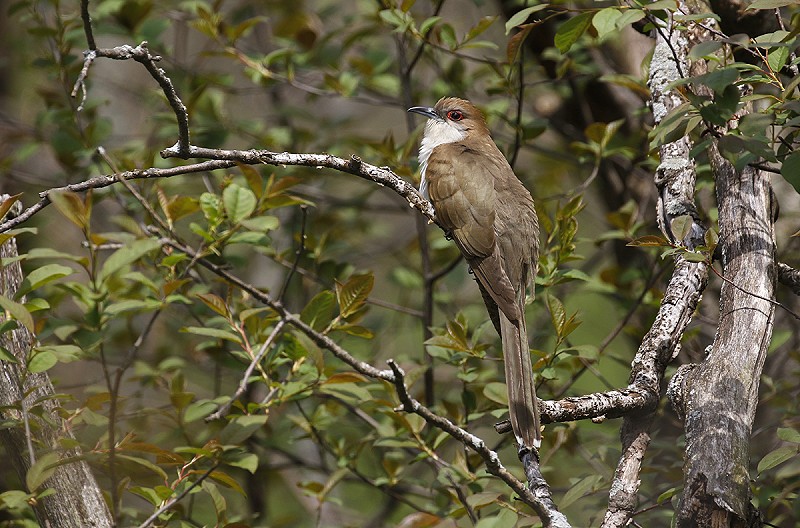 Black-billed Cuckoo Coccyzus erythropthalmus, Point Pelee, 11 May 2022 (Bas van den Boogaard)
Black-billed Cuckoo Coccyzus erythropthalmus, Point Pelee, 11 May 2022 (Bas van den Boogaard)
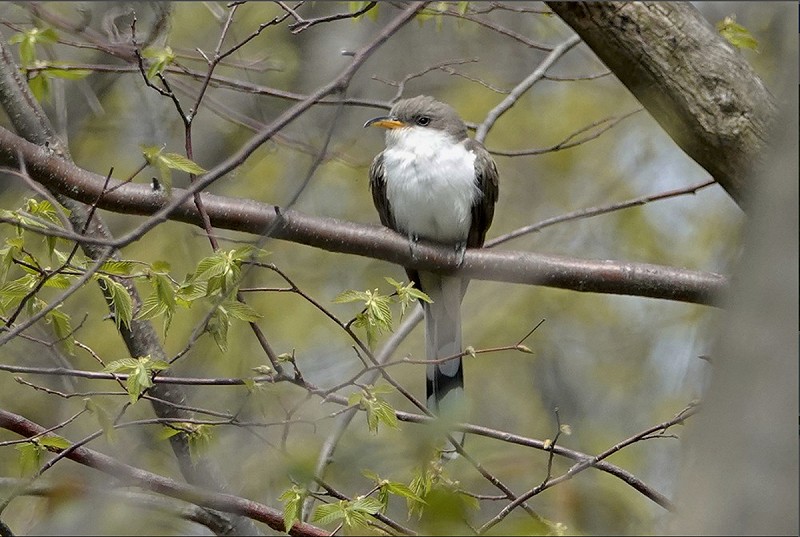 Yellow-billed Cuckoo Coccyzus americanus, Point Pelee, 11 May 2022 (Ruud van Beusekom)
Yellow-billed Cuckoo Coccyzus americanus, Point Pelee, 11 May 2022 (Ruud van Beusekom)
A final word
I didn’t visit Point Pelee for the sake of adding new species to my life list. In fact, having visited North America multiple times, my additions were small (oddly enough, Red-headed Woodpecker was one of them). Having birded less frequently in North America, Ruud and Han were able to add some more new species to their lists.
Our prime attraction to Point Pelee was the sheer volume of birds, and the diversity of North American songbirds that can be seen in a short time. So, if you’re into observing the miracle of bird migration, Point Pelee is one of the places to be! For birders who have not yet been to North America, Point Pelee in spring is certainly a very productive starting point. You can easily combine it with other good birding areas in southern Ontario (like Algonquin Provincial Park).
I would like to thank my travel companions Han Zevenhuizen and Ruud van Beusekom for providing great photos for this article, as well as some additional ideas on the text. Mark Collier kindly did a check on the English text.
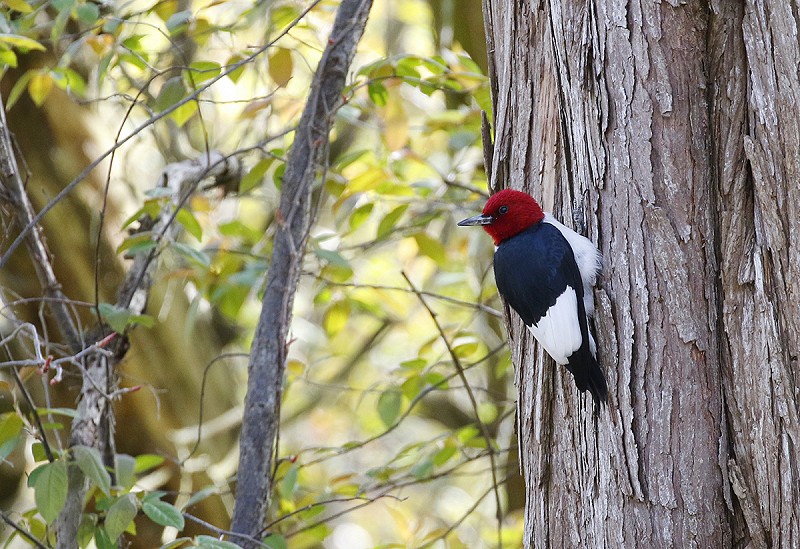 Red-headed Woodpecker Melanerpes erythrocephalus, this species has a wide distribution in eastern U.S. and the extreme south of (eastern) Canada, however, a new species for my list nonetheless! Point Pelee, 11 May 2022 (Bas van den Boogaard)
Red-headed Woodpecker Melanerpes erythrocephalus, this species has a wide distribution in eastern U.S. and the extreme south of (eastern) Canada, however, a new species for my list nonetheless! Point Pelee, 11 May 2022 (Bas van den Boogaard)
Discussie
Jan Hein van Steenis
·
19 April 2023 08:44
Leuk hoor!
Die woodcock ontbreekt nog op mijn lijst, maar dankzij een gulle donatie aan de muggen van Minnesota heb ik de Connecticut Warbler wél. Klinkt haast als een Cetti's – echt een soort die je ook moet horen.
Een paar weinig storende spelfouten zijn er doorgeglipt, maar Lake Erie moet toch echt even verbeterd worden (eerie betekent "eng").
Eduard Sangster
·
19 April 2023 21:34
Mooi stuk en fraaie platen, dank je wel!
Patrick Bouthoorn
·
20 April 2023 08:00
Leuke reis, mannen. Wat een mooie soorten zangers en prachtige foto's. Herinneringen aan mijn Canada\Alaska trip. De Woodcock mis ik ook nog.
Hinderi Tamminga
·
20 April 2023 14:53
Mooi stuk en prachtige foto's! Ik ben er zelf geweest in Mei 2019 en ik kan het iedereen van harte aanbevelen, alleen al om de goeie hotdogs die midden in het park verkocht worden.
Joachim Bertrands
·
21 April 2023 00:12
Erg leuk verslag! Jullie maakten er duidelijk de flinke wave mee van enkele dagen nadat ik er een tour aan het gidsen was (5-7 mei). Toen was het aardig koud, maar desondanks was er wel vanalles te zien.
Prachtige foto's ook!
Folkert Jan Hoogstra
·
9 May 2023 22:04
Op die plek zit nu blijkbaar een Moerassneeuwhoen.
Gebruikers van het forum gaan akkoord met de forumregels.

